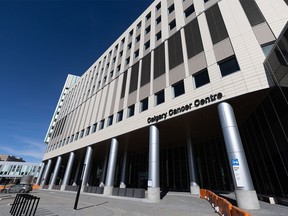Many people diagnosed with cancer soon find they will not get timely care. That’s terrifying and, obviously, medically dangerous

A heartbreaking video is circulating on social media from a young Edmonton woman whose husband was diagnosed with gastric cancer on May 2, but two months later has no appointment to see an oncologist.
She says he’s developed severe related problems and has been in hospital.
Gastric bleeding. Stomach perforation. A collapsed lung.
But the underlying cancer can’t be treated because only oncologists do that.
Since the diagnosis, she says, “we have not set foot in a medical oncologists office, had an appointment or even spoken to any member of the oncology team at the Cross Cancer Institute.”
The woman isn’t hostile to oncologists or the cancer hospital, just a system operating with dire shortages.
Many people diagnosed with cancer soon find they will not get timely care. That’s terrifying and, obviously, medically dangerous.
Cancers advance during these long waits after diagnoses. Sometimes people die.
Radiation oncologist Dr. Shaun Loewen, who practices in Calgary, says “it’s not uncommon for me to see a patient that’s waited three or four months to come to the Tom Baker Cancer Center.”
Dangerous waits even occur after patients have cancer surgery.
Women who undergo procedures to remove breast cancer, without a full mastectomy, must have subsequent radiation treatment, Dr. Loewen says.
“They have to have radiotherapy to the breast tissue in order to lower the chance of recurrence of their cancer.
“A patient needs to be treated within a four-week window after their surgery, but we’re now approaching like 10 or sometimes even 12 weeks before these women can get breast radiotherapy.
“In some situations their cancer has returned during that time, or the cancer has progressed.”
Surely this approaches medical malpractice by the health system. In 2009, a Quebec class action lawsuit on behalf of 4,000 women who faced waits longer than 12 weeks resulted in a $5.4-million settlement paid by several hospitals.
In March, Alberta Health stopped reporting chemotherapy and radiation wait times. “Now we don’t know and neither does the public,” Loewen says.
“We have asked AHS to report cancer care wait times on the AHS website similar to emergency ward wait times. No word so far.”
The core cancer problem is a shortage of both medical and radiation oncologists. Dr. Paul Parks, president of the Alberta Medical Association, says the province would have to recruit half a national graduating class to solve the problem.
“Canada graduates about 50 radiation oncologists and 50 medical oncologists a year, and we’re about 50 short.”
Parks says Alberta simply isn’t an attractive destination for these doctors because of compensation and the lingering memory of the UCP tearing up doctors’ signed pay agreement in 2020.
Parks, an emergency ward doctor in Medicine Hat, says he regularly sees the results.
“Patients come to emergency and I’ll diagnose them with cancer and arrange things, but it can be up to four months for them to get seen by a specialist, to start their treatment.
“You have to see that specialist before any of the actual cancer care plan and treatment can be initiated.”
The video by the Edmonton woman, he says, “really drives it home. Can you imagine having this new diagnosis and just sitting at home waiting to see an expert? That time has to seem like an eternity.”

Alberta Health Services is on the hunt for doctors and says the state-of-the-art facility will be its own attraction.
The Centre “is expected to attract leading cancer experts through our active recruitment using multiple strategies, including international recruitment campaigns in the U.S. and U.K., and working with several post-secondary institutions to provide practicum support,” says spokesperson Kerry Williamson.
About 90 per cent of the hospital staff will come from cancer care locations around the city, he says.
“Recruitment efforts are ongoing and are focusing on hiring numerous positions in professions including nursing, radiation therapist, medical radiation technologists and environmental services.”
Cancer patients in southern Alberta can only hope this works.
Don Braid’s column appears regularly in the Herald